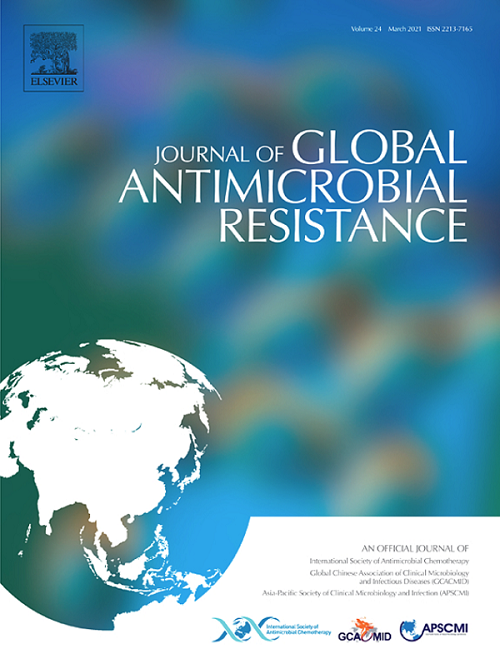韩国一家医院NDM-1产肠杆菌传播的基因组调查
IF 3.2
3区 医学
Q2 INFECTIOUS DISEASES
引用次数: 0
摘要
目的:以前在韩国一家医院收集的临床和环境样本中观察到多种新德里金属β-内酰胺酶(NDM)-1产生肠杆菌。本研究旨在探讨blaNDM-1的传播机制,并评估环境水库在其持续存在中的作用。方法:收集流行病学资料,对2018年11月至2021年2月期间采集的42株临床分离株和13株环境分离株进行抗生素药敏试验、碳青霉烯酶检测和全基因组测序,分别为疫情前、疫情暴发(2019年7月至9月)和疫情暴发后。对4个临床分离株和4个环境分离株进行了长读全基因组测序,以表征携带blaNDM-1和相关移动遗传元件(MGEs)的质粒。还进行了系统发育分析。结果:在临床分离株和环境分离株中检出blaNDM-1。2019年疫情期间,医院内肺炎克雷伯菌和准肺炎克雷伯菌的克隆传播是主要传播机制。暴发后,携带blaNDM-1的IncX3质粒介导的水平基因转移(HGT)是主要的传播机制。该质粒在临床和环境分离株中检测到,与世界上报道的IncX3质粒具有高度的遗传保守性。这些质粒含有保守的MGEs,包括IS26-dsbD-trpF-ble-blaNDM-1结构。结论:本研究强调了克隆传播和质粒介导的HGT在医院环境中blaNDM-1传播中的双重作用。高度保守的IncX3质粒在环境分离株中的持久性强调了碳青霉烯耐药性控制的复杂性。针对患者间传播和环境宿主的综合感染控制策略对于减轻产生ndm的肠杆菌的传播至关重要。本文章由计算机程序翻译,如有差异,请以英文原文为准。
Genomic investigation of NDM-1 producing Enterobacterales transmission in a South Korean hospital
Objective
Prolonged detection of multispecies New Delhi metallo-β-lactamase (NDM)-1-producing Enterobacterales was observed in front of a South Korean hospital. This study aimed to investigate the transmission mechanisms of blaNDM-1 and assess the role of environmental reservoirs in its persistence.
Methods
Epidemiological data were collected, and antibiotic susceptibility testing, carbapenemases detection, and whole-genome sequencing were performed on 42 clinical and 13 environmental isolates collected between November 2018 and February 2021, during the pre-outbreak, outbreak (July–September 2019), and post-outbreak periods. Long-read complete-genome sequencing was performed on four clinical and four environmental isolates to characterize plasmids carrying blaNDM-1 and associated mobile genetic elements. Phylogenetic analyses were also performed.
Results
blaNDM-1 was detected in 15 different species across clinical and environmental isolates. During the 2019 outbreak, clonal spread of Klebsiella pneumoniae and Klebsiella quasipneumoniae in the hospital was the primary mechanism of dissemination. During the post-outbreak period, horizontal gene transfer, mediated by the IncX3 plasmid carrying blaNDM-1, was the dominant transmission mechanism. This plasmid, detected in both clinical and environmental isolates, showed high genetic conservation with IncX3 plasmids reported worldwide. These plasmids contained conserved mobile genetic elements, including the IS26-dsbD-trpF-ble-blaNDM-1 structure.
Conclusions
This study highlights the dual roles of clonal spread and plasmid-mediated horizontal gene transfer in the dissemination of blaNDM-1 in hospital settings. The persistence of highly conserved IncX3 plasmids in environmental isolates underscores the complexity of carbapenem resistance control. Comprehensive infection control strategies targeting patient-to-patient transmission and environmental reservoirs are crucial for mitigating the spread of NDM-producing Enterobacterales.
求助全文
通过发布文献求助,成功后即可免费获取论文全文。
去求助
来源期刊

Journal of global antimicrobial resistance
INFECTIOUS DISEASES-PHARMACOLOGY & PHARMACY
CiteScore
8.70
自引率
2.20%
发文量
285
审稿时长
34 weeks
期刊介绍:
The Journal of Global Antimicrobial Resistance (JGAR) is a quarterly online journal run by an international Editorial Board that focuses on the global spread of antibiotic-resistant microbes.
JGAR is a dedicated journal for all professionals working in research, health care, the environment and animal infection control, aiming to track the resistance threat worldwide and provides a single voice devoted to antimicrobial resistance (AMR).
Featuring peer-reviewed and up to date research articles, reviews, short notes and hot topics JGAR covers the key topics related to antibacterial, antiviral, antifungal and antiparasitic resistance.
 求助内容:
求助内容: 应助结果提醒方式:
应助结果提醒方式:


